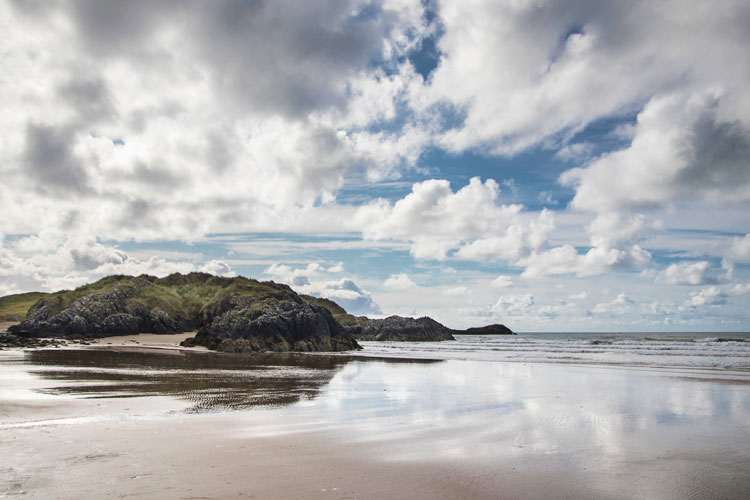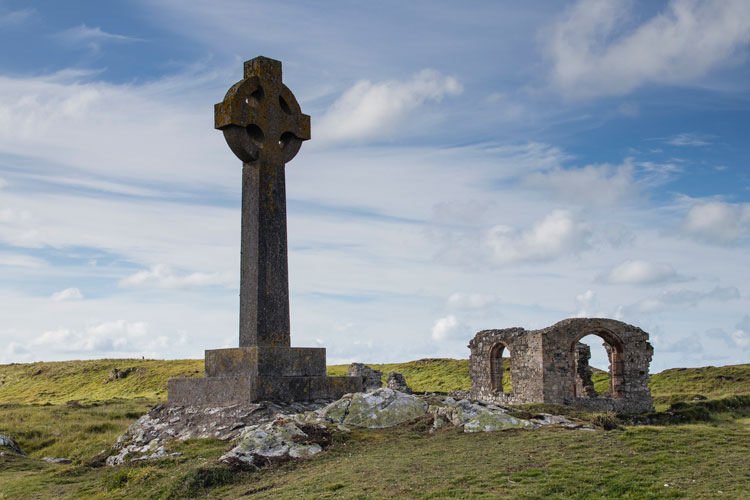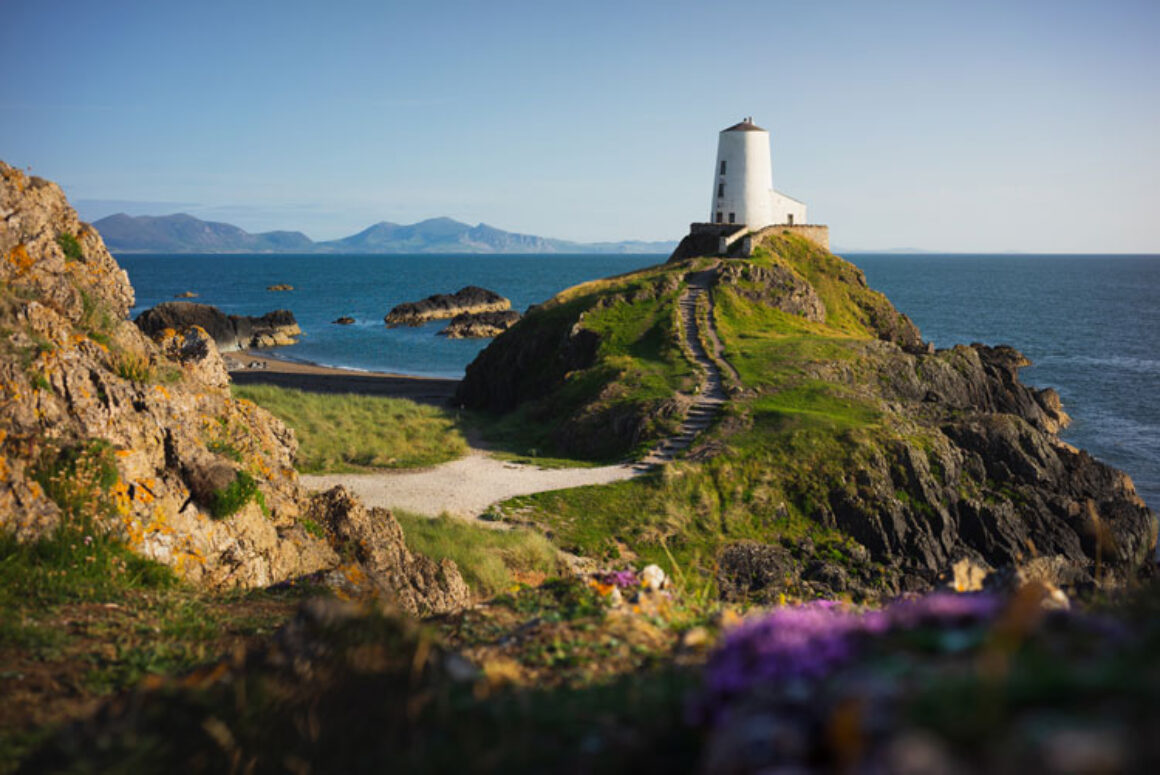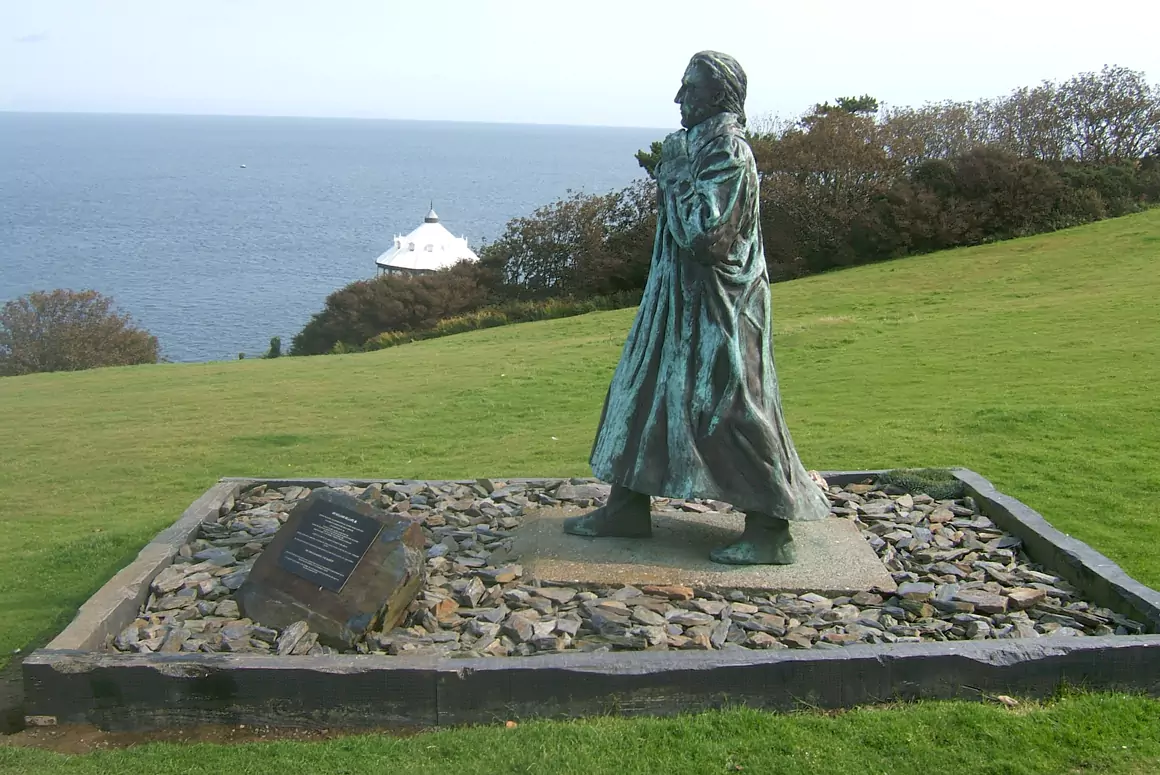![]()
Ynys Llanddwyn is a small tidal island off the west coast of Anglesey (Welsh: Ynys Môn), northwest Wales. The nearest town is Newborough.
Bus Number 42 stopped not far off from Wiwer Goch Café on Pendref St. The Red Squirrel Café. My instructions: turn right at Church Street and keep walking. Two plus miles. The bus driver repeated the bus times, emphasising the last one that could get me back to Holyhead and my B&B. He watched me circle it on the schedule he had given. Mentally, I imprinted to return a whole hour early.
Church Street from Newborough led me past houses, including B&Bs and a church, taking me out to open fields. Occasionally a car drove past, heading as I was – to the beach. Then on my right, I came to the 700-year plus Llys Rhosyr Mediavel Court of the Princes of Gwynedd established by Llewelyn Fawr. In 1992, it was brought to light by archaeologist Neil Johnstone and found to be the only Welsh Princes’ court to be so foundationally complete, giving insight into their life. Due to a horrendous sandstorm about 1330, it was buried. More information is available back in the village at the Pritchard Institute.
Leaving the Mediaeval Court site, I walked on. Fields of gorse, rocks and grassy hillocks spread on either side. White tailed rabbits hopped in and out of invisible holes but disappeared completely as my footsteps announced my approach. Then, I was left with just the wind. Ten minutes later came a gentle drizzle. With open umbrella and quickened pace, leaving the road, I found a kind of shelter amidst trees of oak, larch and tall, tall Corsican pines. The Newborough National Reserve. An area of outstanding beauty. Important for both flora and fauna, the guidebook had read. There the rain hardly reached me. I closed the umbrella and moved through a hushed hall of birdsong with flutterings and rustlings. The red squirrels, I thought. Red squirrels were making a healthy return, helped here in the Reserve.

Finally, ahead of me arched Yr Wyddfa (Mount Snowdon) in Eryri (Snowdonia) across the sea. I could see the Llyn Peninsula too – shrouded in rain. On my left was the car park, adjacent to the shore. I chose the closest sand dune to climb. Before me, the beach was wide. My boots sank in the smooth, pinky brown sand. The waves tumbling in, reminded me not to dawdle. I was aiming for Ynys Llanddwyn. An island when the tide was in. On foot, I needed to reach before that happened so I could spend the few hours before the tide turned again and let me off.
The wind ripped around me. The spray from the waves moistened my face with its salt. Up above the drizzle turned to rain. With my umbrella open again and bracing it against the wind, I hurried. Less than a mile ahead, my destination lay behind a gauzy curtain of sky water. The plan to spend time on the island seemed to be breaking apart, dissolving in the rain and the returning tide.
The draw to the island was Saint Dwynwen. A name meaning she who leads a blessed life. A fourth century princess. A daughter of King Brychan of Brycheiniog. She fell in love with Maelon Dafodrill, the son of the king of Gwynedd. But, her father would not have it. Not only did he not like Maelon, he had already promised this daughter’s hand (there were twenty-four daughters) to another prince. Both Maelon and Dwynwen were distraught. Maelon also angry because she would not disobey her father. What actually happened next changes depending on the storyteller but… Dwynwen distressed, rushed into the woods to pray to fall out of love with Maelon and for his ardour to be cooled. He became a block of ice. Dwynwen is given a sweet potion by an angel to forget her love. Because of her obedience to father and being virtuous, God gave her three wishes. Her choices were: the thawing of Maelon; never to marry and the third, the one which Welsh couples hold dear, is that God would grant true lovers their hopes and dreams. In gratitude, Dwynwen left Brycheiniog for Ynys Mon (Anglesey) and to this island where she established a convent and dedicated her life to God. She died in 465 AD.

The church ruin on the island carries her name. St Dwynwen. Llanddwyn itself means church of St Dwynwen. Built in the 16th century on the original chapel’s site, it was once was a place of pilgrimage – for some it still is. Somewhere between the lighthouse and the church ruin, hidden amidst sharp, craggy rocks, is a well – reputed to foretell the trueness of one’s love. All this leads to January 25th, St Dwynwen’s Day – Wales’ day for lovers. Dydd Santes Dwynwen.
So this was the story in my head, drawing me to cross the narrow strip to find the well, enter the church site, visit with the echo of this saint – maybe even spot the wild cattle or horses. But, the rain instead of decreasing, pummelled down. The gray tide danced higher and even the most determined walkers with whispers of neap tide – including me – turned back.
Getting there:
By car: Newborough (Niwbwrch) is at the junction of A4080 and B4421. Turn west on Church Street to the beach. Park car and walk north along the beach.
It is 45 miles (72 km) forty-eight minutes from Holyhead (Caergybi) on the North Wales Expy/A55. Twelve miles (19 km) from Bangor. Eleven miles (18 km) from Llangefni – both take about 30 minutes by car.
By bus: #42.
Very important tip: Check the tide times before heading out… and the weather.





